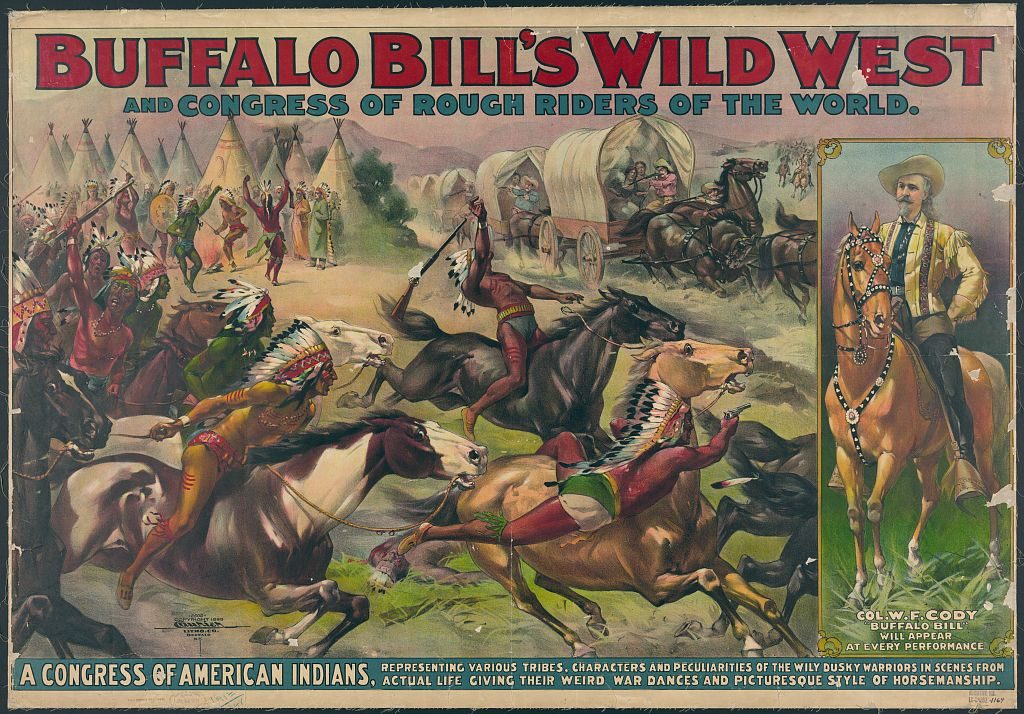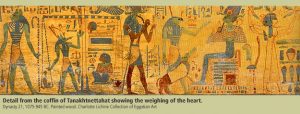In 1883, William “Buffalo Bill” Cody, famous frontiersman, army scout, and buffalo hunter, opened the doors of his Wild West Show for the first time.1 This show was a fantastical, exaggerated portrayal of life on the frontier, complete with reenactments of famous frontier battles with natives, displays by gifted marksmen (and one woman) and horsemen, and shows of the culture of the various Native Americans in Bill’s employ. This show would capture the hearts and minds of many people in the United States, and later on even in Europe, as Buffalo Bill’s show traveled to many European countries between 1886 and 1906.2

One of the reasons for the success of Buffalo Bill’s show was its “authenticity.” Bill himself was already somewhat of a celebrity in the west, after having earned his moniker “Buffalo Bill” for killing some 4,280 buffalo for the Kansas Pacific Railroad Company in the 1860s.3 Bill also had the good business sense to employ many of the Lakota Sioux and other Native Americans, including the man famous for the role he actually played at the Battle of the Little Big Horn, Chief Sitting Bull. It was in its depiction of Native Americans that many of his fans were drawn, enamored by the elaborate songs and dances of these peoples, with Buffalo Bill going so far as to say, “My Indians are the principal feature of this show.”4 The depiction of the Native Americans in his show was largely of their warrior culture, war regalia, and dances made for going into battle; however, this was taking place during the closing of the American frontier, when the death of the buffalo herds and the end of the Sioux Wars had largely ended this way of life in the west.
After roughly four months working with Cody, Sitting Bull grew tired of the show and left to return to the Standing Rock Reservation, where he would eventually be killed. Later in 1890, the Massacre at Wounded Knee would take place and many Sioux would be killed by the U.S. 7th Cavalry, the same regiment that fought with Custer years prior, at the Battle of the Little Big Horn.5 With this, the way of life that was shown in Buffalo Bill’s show was all but destroyed.

Even with this, Buffalo Bill’s Wild West Show continued to be popular up until it went bankrupt and closed in 1916.6 By 1916, the “Wild West” had not truly existed for quite some time; the country had been rapidly industrializing, and the age of both Cowboys and Indians would soon give way to the machine guns and artillery of the First World War. However, it was not the death of the west that ended Bill’s show, but rather the end of interest in the west. Although people praised Bill’s show for its authenticity, it was not authentic to the contemporary west. The show did not feature miles-long slow rides in freezing temperatures on cattle drives, and it did not show subsistence farming. What Buffalo Bill’s Wild West Show gave its audience was the same thing that they grew accustomed to from dime novels and stories of the west: rough and tumble cowboys, crack shots, skilled horsemen, and the Natives that made the west so dangerous. With the closing of the frontier and the nation looking outside of its borders to expand, the west was no longer as exotic as it once was in the public’s eye, and was anything but wild.
- Stephen G. Hyslop, “How the West was Spun,” American History 43, no. 4 (October 2008): 26. ↵
- Irene Lottini, “When Buffalo Bill crossed the ocean: Native American scenes in early twentieth century European culture,” European Journal Of American Culture 31, no. 3 (October 18, 2012): 187. ↵
- Stephen G. Hyslop, “How the West was Spun,” American History 43, no. 4 (October 2008): 27. ↵
- Stephen G. Hyslop, “How the West was Spun,” American History 43, no. 4 (October 2008): 33. ↵
- Stephen G. Hyslop, “How the West was Spun,” American History 43, no. 4 (October 2008): 33. ↵
- Douglas Seefeldt, “Buffalo Bill’s Wild West,” in America in the World, 1776 to the Present: A Supplement to the Dictionary of American History, edited by Edward J. Blum, Vol. 1. (Farmington Hills, MI: Charles Scribner’s Sons, 2016), 163. ↵



63 comments
Lianna Ybarra
Interesting piece! I just read the piece about Wounded Knee Massacre so I know a little background information now. I find it interesting how during this play, he was able to bring about peace upon the Indians but once problems started occurring with the Indians, the show went bankrupt and the massacre happened.
Anayeli Prieto
Wonderful article . I don’t see Capeli very killed almost 5000 buffaloes. To be able to do something like this means to have great skill in hunting down the buffaloes and killing them at the perfect moment. I also am aware of all the uses that they had for the Fur answer me that the used eat and to survive with. It’s unfortunate that this cost almost extension of buffaloes and you don’t see many of them today as they there were a long time ago.
Nelson Smithwick
Unfortunately, many of the buffalo killed by William Cody most likely rotted in the sun. Early on, when the railroads were being built, many bison were killed to be used as food, and their pelts were sold by hunters and trappers. However, men like Buffalo Bill were hired to kill the bison for “safety” reasons. A buffalo could easily derail a train of the day if it were on the rails. Also, many of these hunters would kill bison who were nearby train tracks so that they wouldn’t cause any costly delays for the railroad company. In fact many railroad companies had “train hunts” were passengers could fire at bison as their train passed by a herd. This sadly, was part of the fall of the plains Indian’s way of life.
Johnanthony Hernandez
Well written, and I’ve never been one for the whole Wild West theme. But if I was living in an area that Buffalo Bill’s show was going through, I would have, and still would, go see it. With that said, I didn’t know anything other than he had a traveling show and that they were the thing to see if he was traveling through your area, but this article makes me want to learn more about Buffalo Bill and how the way the portrayed everything went down hill as soon as conflict broke out. Great article and a great amount of information that makes me want to read up more on Buffalo Bill.
Natalia Zuniga
Great job on this article! I had always heard of Buffalo Bill and then Buffalo Bill’s Wild West Show when I was younger. I had never really known what it was and about. This was great see how this was a part of history and how famous it was to even make it to Europe. Overall an excellent and very informative article.
Nahim Rancharan
After reading this article it was easy to see how Buffalo Bill’s Wild West show was an iconic show in American TV history. Clearly, at it’s peak of popularity, the show offered Americans an insight into the Wild West; a story that they were all too familiar with. With the traditional stories of Cowboys and Indians, it seems to have provided people with a different take on what it mean to live like in that particular frontier. Although it had kept a certain level of popularity over the years, the show, like with all other things, was affected by a change in interest of the American populace. With something new and shiny such as the American Industrial Revolution, people had obtained a different interest; the future. Nevertheless, the has still been able to maintain its position as an important part of American History and this article does a great job at highlighting it. Good Job!
Jennifer Pogue
This article was very well written and fun to read. As a child my grandfather often read me old folk tales about the west and we would watch western movies, this reminds me of him. Agreeing with what Nicholas commented, it is sad how the Wild West slowly faded out. It was a interesting, unique and authentic place. I suppose some parts farther west could be considered “wild,” but it is not nearly as new and exciting as it was. Overall great article!
Irene Astran
I would not agree that these shows were necessarily “authentic.” I think that these shows were made to glorify Westerners and demonstrate inferiority among Natives. They may have been famous for showing one side of the cultural divide. However, I do find it very interesting the Sitting Bull himself was casted in these shows. I wonder what led him to resign.
Bailey Rider
This is a interesting article that really pulls in the reader. The story of Buffalo Bill is interesting; it is interesting to learn that he used the “idea of the wild west” to sell his story and get attention for his shows. It was cool to learn that he had Native Americans in his shows and that the population was so interested in the culture and war dances of the Native Americans. It was sad to learn that the population grew tired of the shows however and moved on. Thank you for the article!
Nicolas McKay
This was a great article. I remember reading an article on here about Annie Oakley and her time on the show last semester. I personally am a huge fan of tales from the west, specifically the ones you described as coming from dime store novels, so It was sad to read how the Wild West just slowly died away, along with Buffollo Bill’s show. It is interesting to think how he west we live in, and the west that existed back then are almost completely different things.
Gabriela Serrato
Very interesting article! I had heard the name Buffalo Bill, but never knew any background or history. As an admirer of theatre, I can see how this Wild West Show might have been one of the first signs of theatre making an appearance in America. I admire that the native indians were incorporated and appreciated by Buffalo Bill, but it is extremely unfortunate that the majority met a side end. It is almost ironic that so many indians were killed when a lot of the people who attended and watched the shows did so to admire the indian culture.